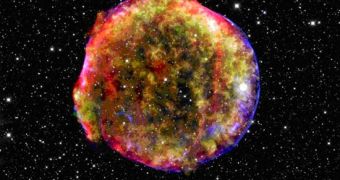In November 1572, Danish astronomer Tycho Brahe saw (or thought he saw) a brand new star in the Cassiopeia constellation, without even using a telescope. In fact, it was a supernova, the violent death of a star, and it was shining so bright that it was visible in broad daylight and even outshone Venus at some point. By March 1574, its light had faded. Now, over four centuries later, contemporary experts can deduce what Brahe saw by measuring light echoes.
Light echoes are light remnants of an old celestial explosion which bounce off the particles of dust from the massive interstellar clouds in the region, and get to the Earth with a delay caused by the distance from the cloud and from the cloud to our planet. Experts from Japan, The Netherlands and Germany have been using the Faint Object Camera and Spectrograph (FOCAS) instrument of the Subaru telescope in Japan in order to detect these echoes from Brahe's Supernova 1572, which span for some 25 light years.
"Using light echoes in supernova remnants is time-traveling in a way, in that it allows us to go back hundreds of years to observe the first light from a supernova event," explained Tomonori Usuda, lead project astronomer at Subaru, quoted by Space. "We got to relive a significant historical moment and see it as famed astronomer Tycho Brahe did hundreds of years ago. More importantly, we get to see how a supernova in our own galaxy behaves from its origin."
The scientists broke apart the echoes into atomic signatures (spectrum) that were present at the initial explosion, which indicated strong evidence of the absorption of the formerly-ionized silicon and of the lack of hydrogen H-alpha emission. These are typical features of a supernova of the Ia type, caused by the explosion of a white dwarf star in a binary system. This makes Supernova 1572 the first confirmed and accurately categorized one in the Milky Way.

 14 DAY TRIAL //
14 DAY TRIAL //